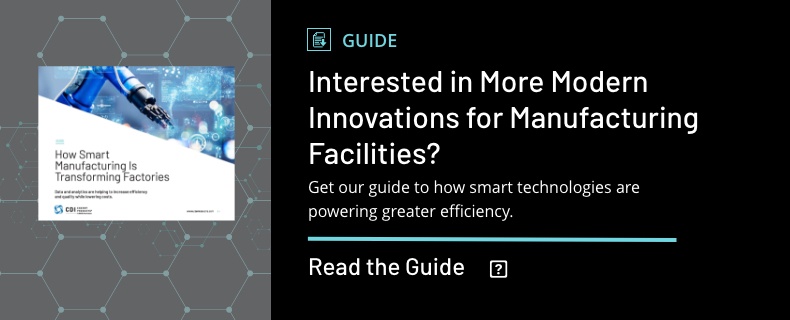
Total Productive Maintenance: 5 Key Benefits for Your Production Line
Posted by CDI Products on Jul 28, 2021
Pop quiz: What’s the best way to handle issues that arise in manufacturing? Here are three of the most common forms of maintenance:
- Reactive Maintenance: Run equipment to failure and provide maintenance when issues arise.
- Preventive Maintenance: Provide maintenance at regularly scheduled intervals to mitigate issues before they arise.
- Condition Monitoring: Monitor equipment through Key Performance Indicators (KPIs) and parameters to take proactive steps as needed.
It’s a trick question – the answer is none of the above. Total Productive Maintenance (TPM), an approach that combines predictive technologies and preventive strategies, is a proven process for enhancing safety, quality, and efficiency in the production process.
Manufacturers are always looking to optimize Overall Equipment Effectiveness (OEE). However, this crucial business goal involves a difficult balancing act between maximizing equipment performance and the risk of incurring machine failure and lost time.
Leveraging the benefits of digital, data-driven solutions, TPM empowers manufacturers to effectively maintain their production lines through heightened visibility and workforce transformation.
This post is your guide to the background on and benefits of this approach to manufacturing – and why you want a manufacturing partner that embraces TPM.
What Is Total Productive Maintenance?
TPM is a holistic process that involves maximizing equipment effectiveness through the active involvement of all the supporting elements of your production line, from equipment to employees and your processes. The goal of TPM is to improve overall productivity and quality by optimizing equipment availability and performance.
TPM is built on the 5S methodology, a workforce organization technique that helps to streamline and standardize facility procedures. Each “S” in this approach can be translated from the original Japanese terms as follows:
- Sort – Simplifying the work area to the bare essentials
- Set in Order – Organizing the remaining components and processes
- Shine – Cleaning and inspecting the work area
- Standardize – Creating standards for carrying out processes
- Sustain – Ensuring that standards are maintained over time
Many variations on this technique exist. Some include “Safety” as a sixth “S,” while some combine the “set in order” and “shine” components. Others break each of these five steps down further into eight individual pillars, including autonomous maintenance, focused improvement, and training and education, to name just a few.
When implemented effectively, TPM offers a road map to improved performance. Eliminating extraneous tools, reducing downtime, and improving consistency contributes to improved production and profitability.
5 Key Benefits of Total Productive Maintenance
While some manufacturers may see maintenance as roadblock or hassle, TPM helps to frame maintenance as a business advantage. Implementing TPM enables manufacturers to decrease planned and unplanned downtime from breakdowns, equipment and maintenance cost, defects, and risk of damage or accidents.
Here’s a more detailed look at five of the key benefits of TPM:
1) Less Unplanned Maintenance and Equipment Downtime
Caring for your equipment through carefully planned and scheduled maintenance ensures your tools are exceptionally well maintained. Implementing proactive maintenance activities results in less equipment failure, minimizing downtime. By helping you avoid lost time and delays, TPM improves OEE, leading in turn to enhanced performance and profitability.
2) Lower Manufacturing Costs
Increasing OEE enables manufacturers to minimize production costs, including expenses related to equipment stoppage time and unplanned repairs. Especially combined with improvements to quality and performance, a decline in breakdown and maintenance costs helps lead to overall higher profits.
3) Heightened Workplace Safety
Leveraging TPM’s 5S method allows for a systematically organized and cleaned workplace. This helps with uncovering underlying problems and challenges to maintaining a streamlined work environment, which in turn leads to fewer accidents and safety risks.
4) Improved Employee Satisfaction
TPM empowers all plant personnel to take ownership and gain confidence in their machines. By making maintenance a personal investment across your workforce, you’ll see greater equipment longevity and better performance from your team. Plus, TPM’s holistic approach to manufacturing encourages innovation through the sharing of cross-departmental knowledge.
5) Higher Quality and Fewer Defects
TPM contributes to the quality and consistency of your production line by maximizing performance. With a higher quality of product and greater speed of delivery, you’ll also have fewer production mistakes to mitigate and, consequently, fewer customer complaints to address.
Though manufacturers are always striving for “perfect production,” unexpected problems can arise even in the best-planned facilities. While achieving perfection on the production floor may not be feasible, facilities that embrace Total Productive Maintenance can streamline performance in their production lines and see wide-reaching business results.
Topic: advanced manufacturing solutions, total productive maintenance
